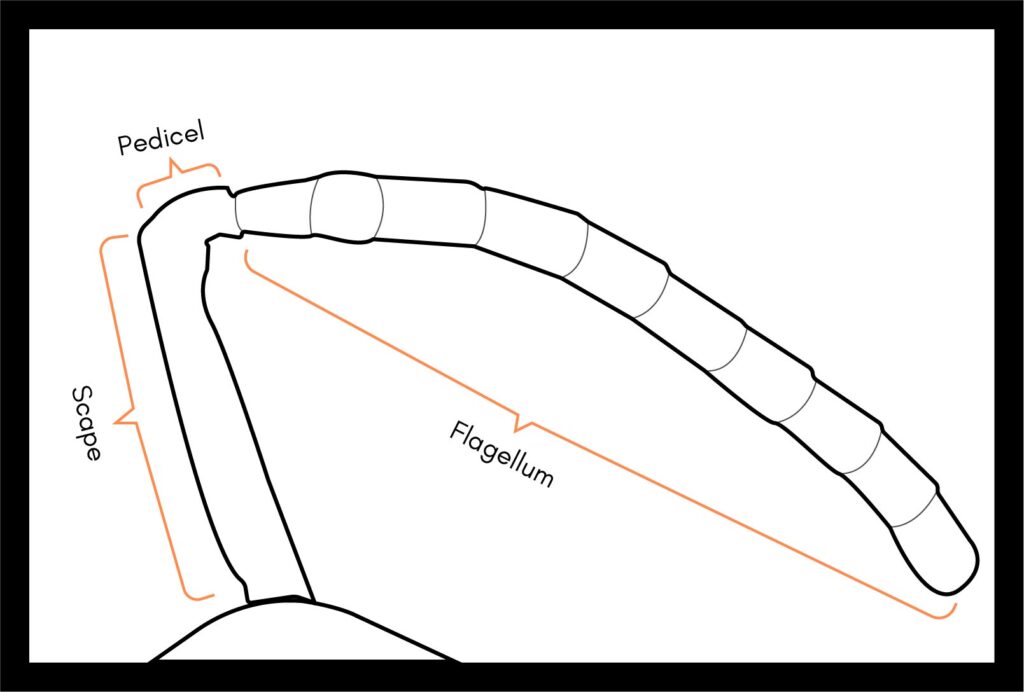Unlike humans, bees don’t have ears, but they can hear! They do this with the help of a special type of organ, called Johnston’s Organ, which picks up vibrations traveling in the air.
Can Bees Hear?
Yes, they can! Only they detect sound differently from other animals and us humans.
You see, sound occurs when objects vibrate, making other particles in the medium they’re in, like air, move and create variations in the pressure of the medium.
For example, when you hit a glass with a spoon, the strike on the glass will create a vibration that will move particles in the air.
These particles will also create changes in air pressure as they move.
In humans and other vertebrates, changes of pressure in the air are picked up by our ears and turned into signals we can process as sound.
But bees don’t have ears. So, unsurprisingly, people just assumed they were deaf.
That was until a famous study in 1989 proved they can perceive airborne sounds.
One of the discoveries was that they identify sounds, but not by detecting the changes in pressure. Instead, they pick up the movement of particles.
Turns out, the beating of bees’ wings, an essential part of their waggle dance communication, create strong particle oscillation in the air but not very strong changes in pressure.
Scientists in the study trained bees to associate certain sounds with a mild electric shock when they visited a feeder to prove bees can hear.
Additionally, they were stimulated with maximum particle movement and pressure and recorded their reaction.
Results showed a higher probability of bees reacting to high-particle movement as told by their antenna movement and lowering of the wings.
How Do Bees Hear?
So… If they can hear but not with the help of ears, how do they do it?
Well, it all happens in the Johnston’s Organ located in the pedicel, the second segment of bees’ antennas.

The Johnston’s Organ (JO) is a chordotonal organ, a unique structure found in arthropods, insects, and crustaceans.
In insects, these organs contain sensory neurons located below the cuticle, and they can detect movement in different body parts.
Chordotonal organs are sensitive to mechanical oscillations, making them good at detecting vibrations in the air.
Johnston’s Organ
The JO consists of sensory units called scolopidia. Each of these units has 2 to 3 neurons and numerous support cells.
It all starts with the movement of particles in the air nearby, causing the flagellum (the third segment of the antenna) to vibrate.
The JO then receives the vibration of the flagellum in relation to the pedicel and converts it into signals that stimulate the neurons.
The neurons then pass the information to the brain to process it further.
Interestingly, not all bees can detect sound. Only bees that are old enough can.
A 2007 study tested the response of the JO neurons to acoustic stimuli on bees of different ages and found significant differences.
More specifically, the vibrations of the flagellum of younger bees gave clues to researchers that their JO wasn’t fully developed in early adulthood.
The neurons in the JO seem to mature with age, and only worker bees old enough to forage can efficiently detect flagellar vibrations.
That makes perfect sense, given communication is an essential part of foraging.
Speaking of bee communication…
How Do Bees Communicate?
Hearing is how we receive the messages from our environment to process them in our brains.
As highly social creatures, communication is essential in the life of a bee colony.
I’ve written before about pheromones and how they send diverse messages like alerting other bees of danger or making sure only one queen (and bee) is in charge of reproduction.
However, there is another way bees communicate with each other, known as the waggle dance.
Waggle dancing is how forager bees tell each other where the good resources are so they don’t waste time and energy during this activity.
Through this dance, a returning forager bee indicates the direction and distance of flowers from the hive.
The dance involves a series of loops and the waggling of the bee abdomen and wing vibrations that generate sounds and air flows.
As the previous section explains, nearby bees will pick up the vibrations and other cues and process them.
During the waggle dance, the bee will also emit a pheromone that, along with the floral odor from the flower the bee has visited, helps speed up the communication process. It makes it faster and easier for other forager bees to understand the location of the flowers. This is just one of many ways bees use their sense of smell to communicate with each other.
Fun fact: the queen also communicates with her colony by making tooting and quaking noises. You can read more about this and other queen bee facts here.
Summing up… Do bees have ears?
No, bees don’t have ears, but they can hear. Nevertheless, bees receive and process sounds differently from humans and other vertebrates.
Honey bees detect the vibration of airborne particles with the help of the Johnston’s Organ, located in their antennas.
The JO receives vibrations from the flagellum and transduces these movements into electrophysiological signals that stimulate the neurons. The neurons then transmit these messages to the brain.
This form of hearing is essential in worker bees. It allows them to communicate with each other and indicate where the floral resources are.
